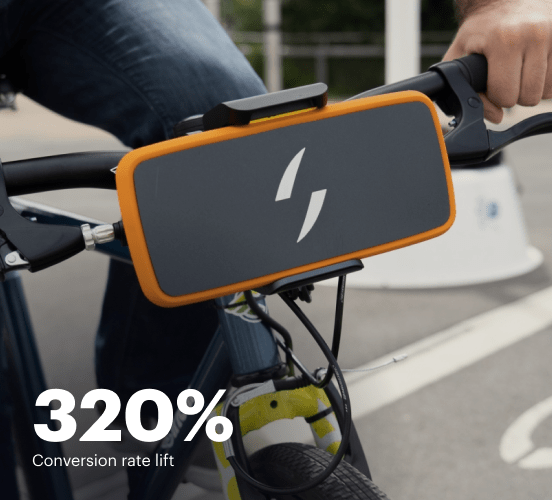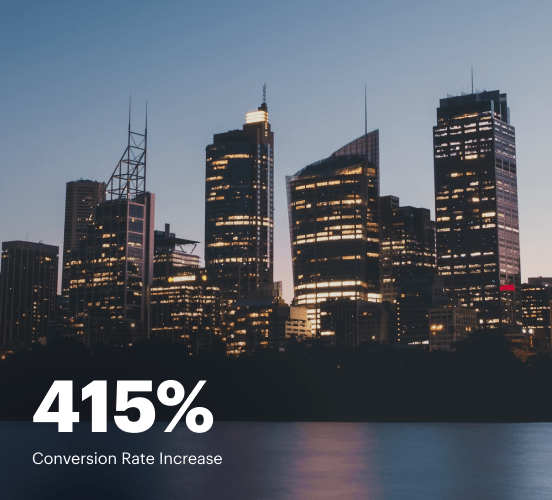Tilda vs. Split.io: the best platform for a seamless web experience
Discover how Tilda compares to Split.io regarding features and usability. Find out which platform provides the competitive advantage your business deserves.
Get startedSee how Instapage stacks up against the competition
| Feature | Instapage | Other builders |
| Drag-and-Drop Tools | ||
| Conversion-optimized templates | ||
| Manual and AI-powered A/B Tests | ||
| AI content suggestions | ||
| Popups and sticky bars | ||
| Canvas and grid blocks | ||
| Reusable and global elements | ||
| Form and popup builders | ||
| Built-in Heatmaps | ||
| Central analytics dashboard | ||
| Ad-to-page personalization and collections | ||
| Contacts, lists, and email | ||
| Dedicated, full-service CRO experts | ||
| Enterprise-ready platform |
Leading the way in building high-performing landing pages





Why Instapage is the smarter choice for your campaigns
Get everything you need to build, scale, and optimize high-converting landing pages—without coding.

Easier page building without coding
Instapage offers a flexible and seamless page creation experience with a library of 500+ conversion-focused layouts, Instablocks®, a drag-and-drop builder, and AI content generation. With technologies like Thor Render Engine®, you can create on-brand, mobile-responsive landing pages that load quickly and start converting during initial visitor clicks.

More insights — better results
Instapage lets you see in detail how each landing page experience and variation is performing so you can make targeted changes that boost page conversions. Use heatmaps for a better understanding of on-page activities, run A/B tests and AI-assisted experiments, and then track and evaluate results within robust analytics dashboards.

More personalized experiences
Instapage lets you quickly create high-performing landing pages tailored to each of your ad campaigns. Deliver personalized experiences for distinct audiences using dynamic text replacement. Effortlessly align specific advertisements to unique pages with AdMaps. Monitor audience-level metrics using our advanced data tools.

Built-in collaboration
Instapage collaboration capabilities bring your entire team together to speed up the process of landing page review, approval, and launch. No more frustrating and unnecessary revisions or edits scattered across emails. Provide instant feedback, conduct real-time page edits, and securely share your pages with outside stakeholders.

Free up time for your business
Invest time into business growth, not busy work. Launch landing pages faster with reusable forms and templates. Build once, reuse forever.
Explore all integrations






Easier page building without coding
Instapage offers a flexible and seamless page creation experience with a library of 500+ conversion-focused layouts, Instablocks®, a drag-and-drop builder, and AI content generation. With technologies like Thor Render Engine®, you can create on-brand, mobile-responsive landing pages that load quickly and start converting during initial visitor clicks.
More insights — better results
Instapage lets you see in detail how each landing page experience and variation is performing so you can make targeted changes that boost page conversions. Use heatmaps for a better understanding of on-page activities, run A/B tests and AI-assisted experiments, and then track and evaluate results within robust analytics dashboards.
More personalized experiences
Instapage lets you quickly create high-performing landing pages tailored to each of your ad campaigns. Deliver personalized experiences for distinct audiences using dynamic text replacement. Effortlessly align specific advertisements to unique pages with AdMaps. Monitor audience-level metrics using our advanced data tools.
Built-in collaboration
Instapage collaboration capabilities bring your entire team together to speed up the process of landing page review, approval, and launch. No more frustrating and unnecessary revisions or edits scattered across emails. Provide instant feedback, conduct real-time page edits, and securely share your pages with outside stakeholders.
Free up time for your business
Invest time into business growth, not busy work. Launch landing pages faster with reusable forms and templates. Build once, reuse forever.
Explore all integrationsGet started with Instapage in a few steps
-
Create your Instapage account
Start with Instapage by signing up via Google or your email. You'll get access to a free 14-day trial to discover Instapage capabilities. Feel free to cancel anytime during the 14-day trial if you decide that our product is not suitable for your business. -
Build and personalize your page
Create your first landing page from scratch or choose a template from 500+ customizable layouts. Use the drag-and-drop builder to add page elements, fonts, and backgrounds, refine content with AI, or add custom HTML, Javascript, and CSS. -
Review and make edits
Collaborate on page designs and streamline review processes. Invite your team members and stakeholders to review, edit, and provide feedback on your landing page. Collaborate knowing your page is confidential and only accessible to authorized users. -
Publish and track page performance
Publish your page to a domain or custom URL. Connect your pages to the ads you've created and track page performance within the analytics dashboard, run A/B tests and AI experiments, analyze results, and continuously optimize your landing page to maintain high conversions.
Tilda vs. Split.io: A Friendly Face-Off in Landing Page Creation
In the bustling ecosystem of digital marketing, businesses are always on the lookout for tools that help them stand out. Enter Tilda and Split.io, two formidable players in the realm of landing page builders, each vying for attention from marketers and entrepreneurs alike. Tilda brings a design-centric approach, boasting an impressive library of templates and an intuitive interface that attracts creatives. The clean aesthetic, paired with customizable blocks, provides users the chance to create visually stunning pages without needing extensive coding knowledge. In contrast, Split.io focuses on experimentation and optimization, allowing marketers to run A/B tests effortlessly, helping them understand what resonates with their audience. This dynamic duo showcases how the landscape of landing pages continues to evolve, with each tool carving out its niche. As we compare these two platforms, it's essential to also acknowledge Instapage, the sleeper hit in this competition, known for its extensive features and user-friendliness. As we navigate through this comparison, it becomes evident that while Tilda and Split.io have their celebrated strengths, Instapage quietly nudges ahead, promising comprehensive solutions for marketers. Hang tight as we break down their offerings in depth, revealing not just their features, but how they stack up against each other and the looming presence of Instapage.
The Contenders: Who Are They?
When thinking of landing page builders, Tilda and Split.io leap to the forefront. Tilda dazzles with its design-focused philosophy, giving users a canvas to express their creativity and bring their visions to life through captivating visuals and layouts. It’s a process that invites experimentation while ensuring the final product can captivate visitors. Split.io, on the other hand, is more of the data-driven strategist in the ring. This platform champions a scientific approach, allowing marketers to run multiple versions of a page and evaluate them in real-time. It’s about making informed decisions based on user behavior rather than relying solely on opinions. In this arena, Instapage looms large, presenting a suite of features that not only compete with Tilda and Split.io but often exceed them. Known for its robust analytics, streamlined interface, and comprehensive support, Instapage essentially represents the best of both worlds – a designer’s utopia paired with a marketer’s analytical toolbox. As we look closer, it's clear that each platform has carved out its strengths, but with Instapage in the background, the competition becomes even more thrilling.
Feature Showdown: What’s Inside the Toolbox?
Let's dive into the detailed features that make Tilda and Split.io stand out from the crowd. Tilda comes packed with a wealth of user-friendly capabilities that cater to those prioritizing design. Users enjoy drag-and-drop functionality, enabling them to assemble their landing pages effortlessly. Built-in SEO tools help them optimize their creations for search engines, while its extensive template library ensures that users start with inspiration rather than a blank canvas. Moreover, Tilda supports responsive design, ensuring that pages look great on any device, a crucial factor in today's mobile-first world. Meanwhile, Split.io isn't just sitting back; it packs its punch with robust A/B testing features that allow users to experiment with different designs, layouts, and calls to action. The platform also boasts a comprehensive analytics dashboard that provides insights on user interaction, enabling marketers to fine-tune their strategies based on real data. But wait, there's a wildcard in the background: Instapage. Known for its advanced features such as custom reporting, collaboration tools, and integration capabilities, it sets itself apart as a powerful tool for teams needing more than just basic functionalities.
Usability Unpacked: Who Makes It Easy?
The user experience is a critical aspect of any landing page builder, and both Tilda and Split.io cater to different types of users. Tilda is often lauded for its sleek, intuitive interface, designed to accommodate users from various skill levels. Newbies can easily navigate the platform, thanks to its well-organized structure and straightforward design tools. Yet, even seasoned professionals find value here due to the various customization options available. On the flip side, Split.io, while featuring a learning curve more suited for the analytical thinker, offers rich resources that help users maximize their experience—from tutorials to community forums. The challenge is balancing the need for depth and usability. Moreover, the third contender, Instapage, presents a seamless experience that merges the intuitive design found in Tilda with the analytical depth offered by Split.io. Its user interface is clean and navigable, with helpful prompts leading users through the page creation process, ensuring even the most complex features are just a few clicks away. In this round of usability, it's clear that Instapage could take the crown for balancing ease of use with feature richness.
Tilda’s Toolkit: Features to Highlight
- Intuitive drag-and-drop page builder
- Wide variety of customizable templates
- Built-in SEO optimization tools
- Seamless integration with third-party services
- Responsive design for all devices
Split.io’s Arsenal: Key Features at a Glance
- Powerful A/B testing capabilities
- In-depth user analytics dashboard
- Dynamic segmentation for better targeting
- Real-time performance tracking
Common Ground: Features Both Platforms Share
- Fast loading times
- Mobile responsiveness
- Integration capabilities with marketing tools
- User-friendly design interfaces
- Support channels for user assistance
- Analytics to track user engagement
As we map out the features, it’s clear both Tilda and Split.io are more than just players in the field—they're skilled competitors. However, while both are producing an impressive show of capability, Instapage can be seen as the overarching solution that combines the best of what these platforms offer, cementing its status as a major contender in the market. As we transition into examining the performance aspects, it’s essential to recognize that while the rivals are busy trading blows, they’re each backed by the subtle backdrop of Instapage—a match-winner lurking behind the scenes.
Performance: Load Times and Responsiveness
Performance is a key factor when considering landing page builders. Both Tilda and Split.io take this aspect seriously, yet they each bring unique strengths to the table. Tilda often prides itself on lightning-fast loading times, crucial for capturing the attention of online visitors who have the attention span of a goldfish. Visitors aren't likely to stick around if a site crawls like molasses in winter, making Tilda’s performance an essential aspect of its user appeal. Split.io also doesn’t fall short, with strong performance metrics that ensure users benefit from fast loading and responsive designs that adjust beautifully across devices. However, it’s worth noting that Instapage often comes out on top in this arena, with unparalleled speeds and integrations optimized for mobile use. Its focus on reducing friction for user navigation keeps visitors engaged and encourages them to interact with the content. In this round, while Tilda and Split.io put up a solid defense, Instapage dominates due to its exceptional speed and user experience facilitated by performance-focused design principles.
Support: Who’s in Your Corner?
Support is a critical consideration for anyone using a digital tool. For Tilda users, the support team is described as responsive and helpful, offering a mixture of resources from tutorials to direct assistance. The community built around Tilda is an additional plus, providing a networking opportunity for users to share best practices. Split.io, on the contrary, shines with its emphasis on comprehensive documentation and community forums, allowing users to help themselves through a robust knowledge base filled with troubleshooting tips and best practices. Yet, as we look at Instapage, it's hard to overlook its extensive support framework; the platform provides live chat options and dedicated customer service teams trained to offer immediate assistance. Here, Instapage secures a winning position by combining self-service solutions with direct one-on-one support for users who need it most. This makes it clear that while Tilda and Split.io bring their best teams forward, Instapage has a ring of champions ready to back users up every step of the way.
Pricing Wars: A Game of Value
Tilda’s Price Tag: The Advantages
- Affordable pricing plans for startups and small businesses
- Flexible subscription options to suit varied needs
- No hidden fees, making budgeting easier
- Free plan available for basic usage
Split.io’s Pricing Strategy: Pros and Cons
- Competitive pricing for a robust testing platform
- Tiered plans for different levels of need
- Offers a free trial to test features
- May become costly as more advanced features are added
When delving into the pricing strategies of Tilda and Split.io, it becomes evident that both platforms offer unique advantages. Tilda ensures affordability, making it an attractive option for startups, while Split.io's pricing remains competitive, especially for those needing testing capabilities. However, when we stack them against Instapage, it becomes increasingly clear that Instapage provides the best value for money. Its comprehensive feature set, paired with flexible pricing, provides options that cater to diverse business needs without compromising on quality.
Now, let’s pull back the curtain on their pricing plans. Tilda offers a straightforward subscription model without the usual hidden fees, presenting a transparent view of costs. Similarly, Split.io offers flexible plans tailored for various business requirements, but with the caveat of potentially escalating costs as businesses scale. The bottom line is simple: when making investment decisions in landing page builders, the adage of getting what you pay for rings true, reminding users to also look for hidden gems like Instapage that seamlessly provide value and rich features.
And Then There's Instapage: The Unsung Hero
In the midst of Tilda and Split.io's competitive clash, Instapage emerges not just as a participant but as a mentor—a seasoned player capable of offering something uniquely beneficial. With its intuitive design interface, high-performing templates, and unparalleled support, it embodies the qualities that both Tilda and Split.io strive to project but often miss the mark on. Instapage crafts an experience that caters to both novice and seasoned marketers, providing a nurturing environment for creativity paired with analytical insights. What sets it apart is its ability to seamlessly blend robust features with ease of use, allowing users to whip up captivating pages while gaining actionable insights into what works best. Furthermore, the platform champions conversion-focused solutions, ensuring that every landing page not only looks good but also drives results. As we wrap up our exploration of these platforms, it’s important to highlight that while Tilda and Split.io are top-notch contenders, Instapage may indeed be the secret weapon marketers need. It invites users toward a pathway of discovery and growth, suggesting that sometimes, the best choice might not always be the most obvious one in the ring of digital marketing. With this in mind, we encourage readers to consider their goals carefully and explore how Instapage, alongside Tilda and Split.io, can help you unleash the full potential of your marketing efforts.










